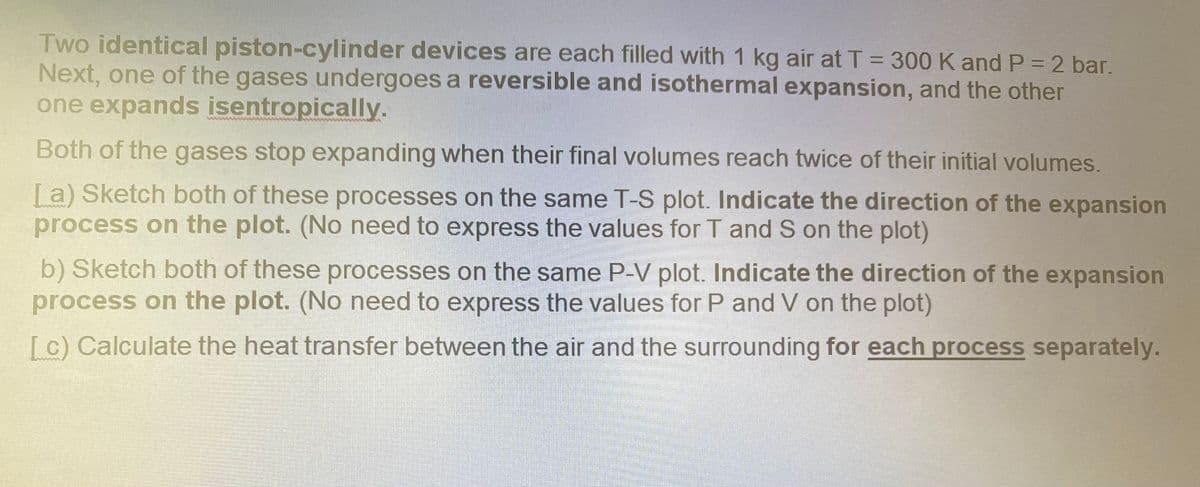Two identical piston-cylinder devices are each filled with 1 kg air at T = 300 K and P= 2 bar. Next, one of the gases undergoes a reversible and isothermal expansion, and the other one expands isentropically. Both of the gases stop expanding when their final volumes reach twice of their initial volumes. [a) Sketch both of these processes on the same T-S plot. Indicate the direction of the expansion process on the plot. (No need to express the values for T and S on the plot) b) Sketch both of these processes on the same P-V plot. Indicate the direction of the expansion process on the plot. (No need to express the values for P and V on the plot) [c) Calculate the heat transfer between the air and the surrounding for each process separately.
Two identical piston-cylinder devices are each filled with 1 kg air at T = 300 K and P= 2 bar. Next, one of the gases undergoes a reversible and isothermal expansion, and the other one expands isentropically. Both of the gases stop expanding when their final volumes reach twice of their initial volumes. [a) Sketch both of these processes on the same T-S plot. Indicate the direction of the expansion process on the plot. (No need to express the values for T and S on the plot) b) Sketch both of these processes on the same P-V plot. Indicate the direction of the expansion process on the plot. (No need to express the values for P and V on the plot) [c) Calculate the heat transfer between the air and the surrounding for each process separately.
Elements Of Electromagnetics
7th Edition
ISBN:9780190698614
Author:Sadiku, Matthew N. O.
Publisher:Sadiku, Matthew N. O.
ChapterMA: Math Assessment
Section: Chapter Questions
Problem 1.1MA
Related questions
Question

Transcribed Image Text:Two identical piston-cylinder devices are each filled with 1 kg air at T = 300 K and P= 2 bar.
Next, one of the gases undergoes a reversible and isothermal expansion, and the other
one expands isentropically.
Both of the gases stop expanding when their final volumes reach twice of their initial volumes.
[a) Sketch both of these processes on the same T-S plot. Indicate the direction of the expansion
process on the plot. (No need to express the values for T and S on the plot)
b) Sketch both of these processes on the same P-V plot. Indicate the direction of the expansion
process on the plot. (No need to express the values for P and V on the plot)
[ c) Calculate the heat transfer between the air and the surrounding for each process separately.
Expert Solution
This question has been solved!
Explore an expertly crafted, step-by-step solution for a thorough understanding of key concepts.
Step by step
Solved in 2 steps with 4 images

Knowledge Booster
Learn more about
Need a deep-dive on the concept behind this application? Look no further. Learn more about this topic, mechanical-engineering and related others by exploring similar questions and additional content below.Recommended textbooks for you

Elements Of Electromagnetics
Mechanical Engineering
ISBN:
9780190698614
Author:
Sadiku, Matthew N. O.
Publisher:
Oxford University Press

Mechanics of Materials (10th Edition)
Mechanical Engineering
ISBN:
9780134319650
Author:
Russell C. Hibbeler
Publisher:
PEARSON

Thermodynamics: An Engineering Approach
Mechanical Engineering
ISBN:
9781259822674
Author:
Yunus A. Cengel Dr., Michael A. Boles
Publisher:
McGraw-Hill Education

Elements Of Electromagnetics
Mechanical Engineering
ISBN:
9780190698614
Author:
Sadiku, Matthew N. O.
Publisher:
Oxford University Press

Mechanics of Materials (10th Edition)
Mechanical Engineering
ISBN:
9780134319650
Author:
Russell C. Hibbeler
Publisher:
PEARSON

Thermodynamics: An Engineering Approach
Mechanical Engineering
ISBN:
9781259822674
Author:
Yunus A. Cengel Dr., Michael A. Boles
Publisher:
McGraw-Hill Education

Control Systems Engineering
Mechanical Engineering
ISBN:
9781118170519
Author:
Norman S. Nise
Publisher:
WILEY

Mechanics of Materials (MindTap Course List)
Mechanical Engineering
ISBN:
9781337093347
Author:
Barry J. Goodno, James M. Gere
Publisher:
Cengage Learning

Engineering Mechanics: Statics
Mechanical Engineering
ISBN:
9781118807330
Author:
James L. Meriam, L. G. Kraige, J. N. Bolton
Publisher:
WILEY